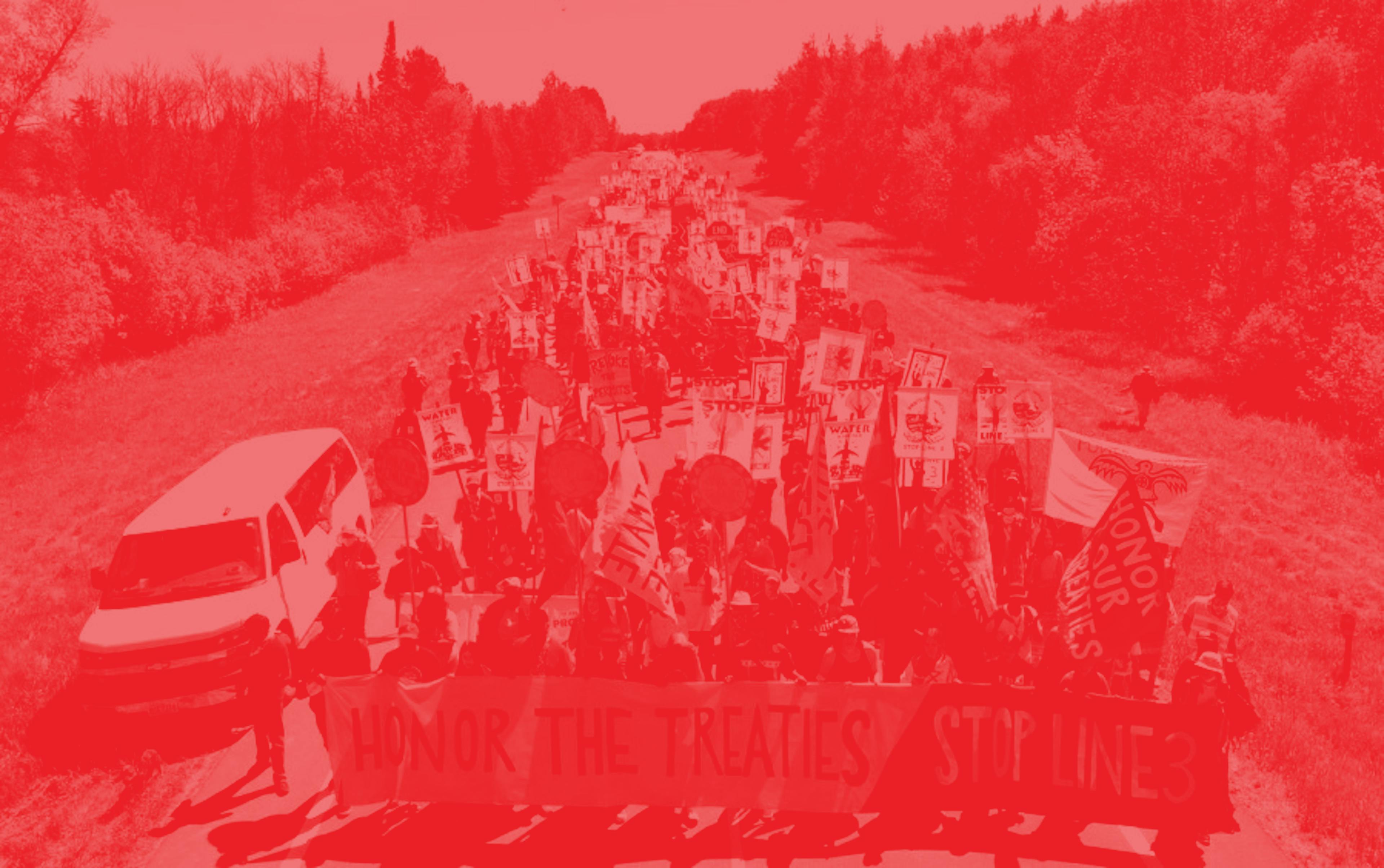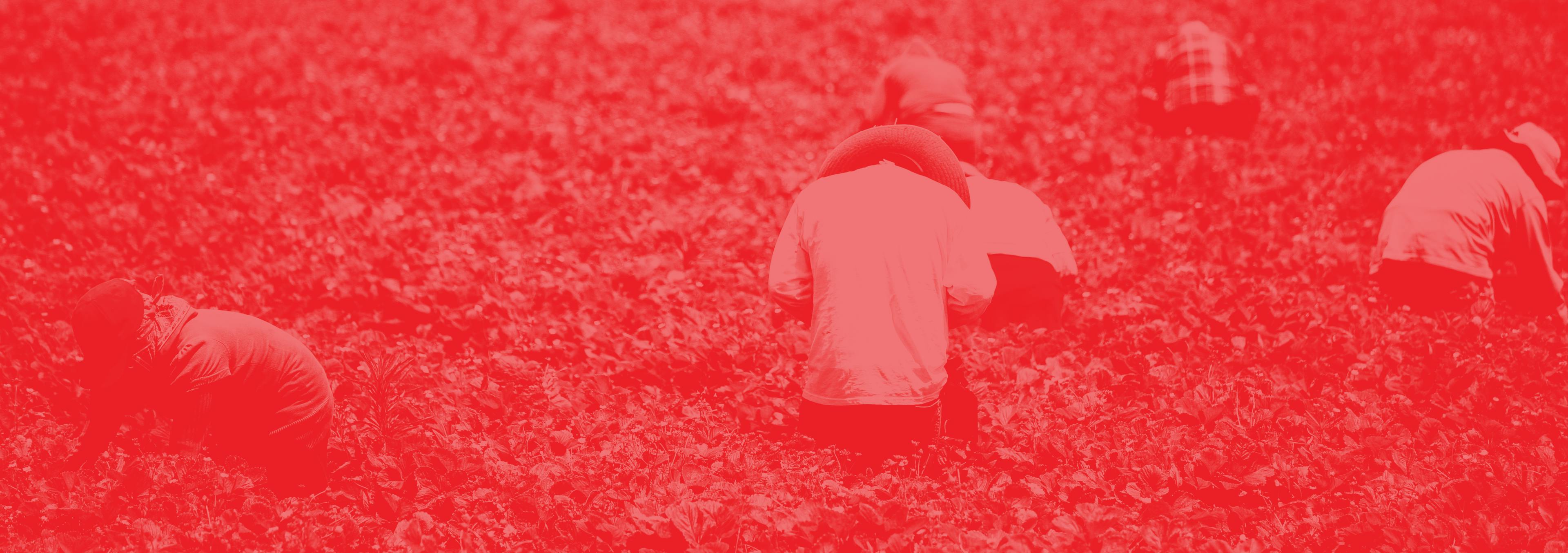
Pesticide-Free Futures Begin with the Right to Know: A Brief History of the Fight Against Pesticide Racism in California Agriculture
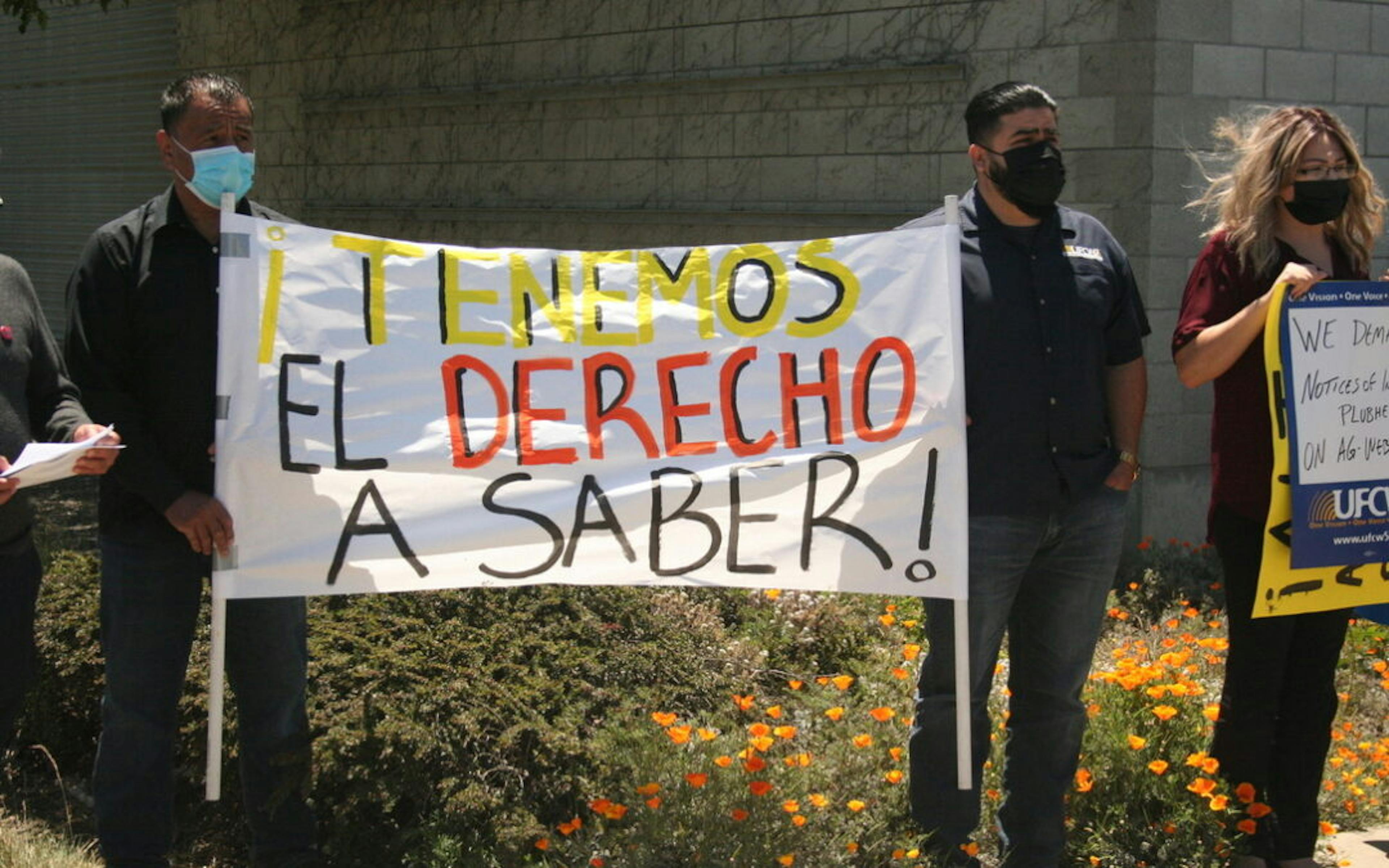
Activists from Californians for Pesticide Reform call for the right to know when and where pesticides are applied. Photo: Californians for Pesticide Reform.
Pesticide drift has been a long-running problem in California's agricultural regions. "Drift" refers to the airborne movement of pesticide residues or particles to communities that may be miles away from where they are use. In the Monterey Bay Region of California, long-distance drift of a fumigant pesticide known as chloropicrin regularly causes acute pesticide poisoning events, causing burning eyes, nausea, and breathing difficulties among those living in downwind neighborhoods (Glowa, 2015; Picazo, 2018). Countless other cases of pesticide poisoning go unreported. This is especially likely in agricultural communities that are exposed to low levels of pesticide drift throughout their lifetimes, leading to high rates of cancer, asthma, skin irritation, learning disabilities, and birth defects – the links to pesticide drift only becoming apparent years down the road (CHAMACOS study; NRDC report).
There is virtually no place in the Monterey Bay Region in the vicinity of a farm that has not been touched by pesticide drift. Growers in this region tend to apply pesticides once per field per growing season. Practically speaking, agricultural communities should be able to take steps to minimize their exposure to pesticide drift if they are given enough advance notice of its applications; but they are not given the opportunity.
The County Agricultural Commissioners who receive and approve Notices of Intent for pesticide applications keep the information secret. The public can only request to view the Notices after pesticides have already been applied – when it is too late.
In the Monterey Bay region, a coalition of over 50 organizations and individuals called Safe Ag Safe Schools (SASS) is organizing to protect school-age children from pesticide drift. SASS member organizations were instrumental in California's 2019 ban of chlorpyrifos, an organophosphate pesticide linked to brain damage in school-age children. They have now turned their attention to the campaign to make the Notices of Intent public.
But the fight will be neither easy nor quick. Learning about the depth of the connections between industrial agriculture, chemical manufacturing, and regulatory agencies is key to organizing against pesticides. To that end, the Santa Cruz chapter of Science for the People has been working to uncover the imperialist roots of industrial agriculture, the centrality of pesticides in California's specialty-crop agriculture, the political vulnerabilities of migrant farmworkers, and how agricultural communities in California are reasserting their agency by organizing for the "Right to Know" when pesticides are applied.
Working Under Industrial Agriculture
The Monterey Bay Region is home to a type of agriculture best descibed as industrial. Industrial agriculture can be identified by its large, single-crop fields, its heavy use of fertilizers and pesticides, and its reliance on cheap labor and expensive farm equipment. Over the past several decades, indu strial agriculture has come to be known as the "conventional" norm for food production. Its intended goal was to end hunger and poverty in the Global South through increased food production, under the banner of a "Green Revolution". In retrospect, however, the industrial model's greatest success has been in creating a market for farming technologies, in which large corporations have accumulated massive wealth.
Agribusiness corporations have amassed fortunes by selling a patented suite of seeds, synthetic fertilizers, and chemical pesticides, while exploiting the availability of cheap farm labor. This system has encouraged growers to simplify their fields, establishing economies of scale. But this comes at the expense of the destruction of the livelihoods of small and peasant farmers around the world, whose traditional land uses could otherwise sustain diverse food systems by tapping into an intimate knowledge of their local ecologies. Combined with falling crop prices, the industrial model has instead shouldered many small farmers with debt or pushed them out of agriculture altogether. Many of the small farmers driven out of business by industrial agriculture have ended up as landless farmworkers.
Agribusiness corporations have amassed fortunes by selling a patented suite of seeds, synthetic fertilizers, and chemical pesticides, while exploiting the availability of cheap farm labor.
The environmental costs have been just as steep as labor's. By concentrating breeding efforts on a small handful of high-yielding crops, industrial agriculture has done away with rich plant lineages that give traditional food systems their characteristic diversity. By applying synthetic fertilizers, often to such an extent that they leach into groundwater and waterways, industrial agriculture pollutes drinking water with nitrates and creates oxygen-depleted "dead zones" that kill off aquatic life. By following an annual planting system, which requires frequent tillage of the soil, industrial agriculture depletes stocks of soil organic matter, which diminishes soil's capacity to act as a carbon sink and to sustain future crop production cycles. And pesticides, for their part, often have non-target effects. Counterproductively, pesticides harm the natural enemies of pest species which might otherwise keep pest populations in check. And as noted by organizations like SASS, the drift or misapplication of pesticides impairs human health, especially in communities who live and work on the frontlines where pesticides are used.
With the imposition of industrial agriculture in India and Mexico, the Green Revolution brought about dramatic changes. The same model also dominates current food production in the Global North. Because of its peculiar history, agriculture in California has been, if anything, more amenable to the industrial model than other regions in the U.S.
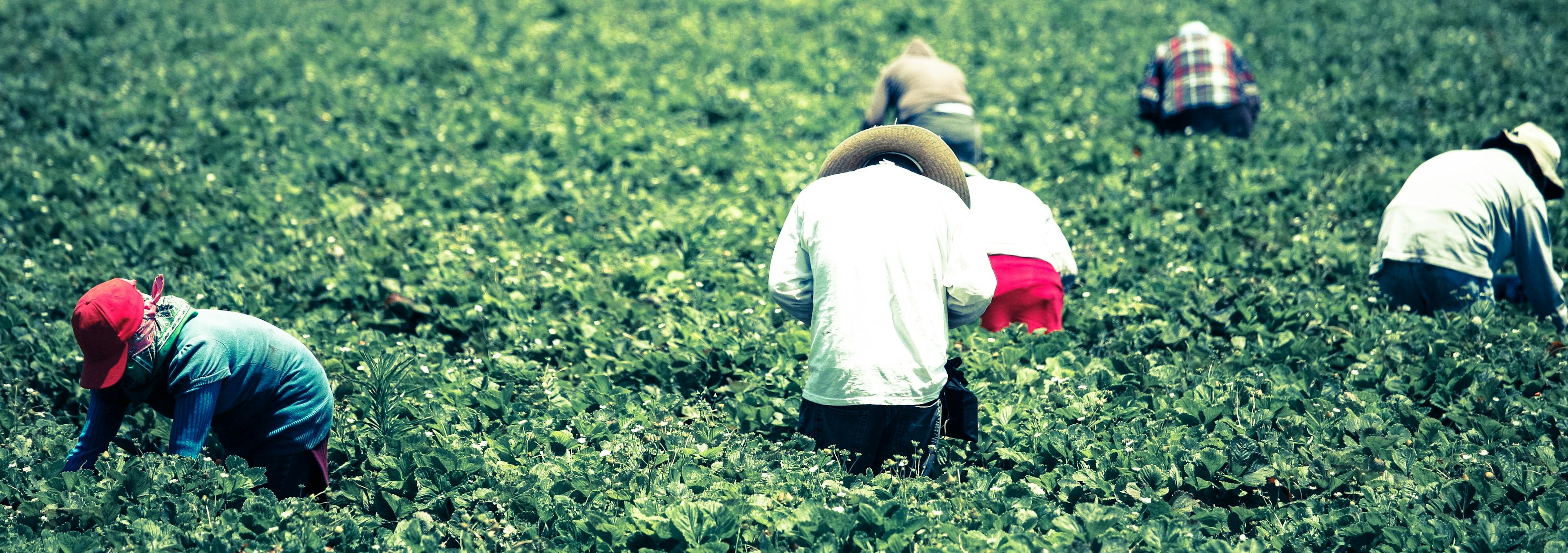
Farmworkers pick strawberries near Oxnard. Photo: Alex Proimos, license: CC BY 2.0.
Across the range of orchards, vineyards, and fruit and vegetable farms across the state, what diverse farmworkers have all shared throughout California's US history is their powerlessness.
Shortly after California was incorporated as a state, its agricultural sector became dominated by large-scale farms that had more in common with the plantations of the pre-Civil War South than the small family farms of much of the Northeast and Midwest. Key to the growth of industrial agriculture in California was the class divide separating farm "workers" from "growers." It is no accident that this class divide has fallen along racial lines. The demographics of the farmworker population has changed over time – from the Indigenous and Chinese workers of the 19th century, to the Filipino/a and Japanese workers of the early 20th century, to the Central American workers of the late 20th and 21st centuries and the Mexican workers for at least the last century. Throughout this history, the most marginalized people in California were often the ones who found themselves working on the farm under dangerous conditions. Across the range of orchards, vineyards, and fruit and vegetable farms in the state, what diverse farmworkers have all shared throughout California's US history is their powerlessness.
Over 90 percent of US farmworkers are immigrants, and half of these are undocumented. In California it is often the most recent group of immigrants that suffers the most abuse and exploitation. Currently the most recent arrivals are the 120,000 indigenous Mexican farmworkers in California, representing about 17 percent of farm labor in the state. Many are native speakers of languages other than Spanish and have already suffered discrimination and poverty in Mexico. Now they face unusually challenging conditions working in the fields of California for an industry known for its harshness. Housing (especially in the Watsonville area) and health care are particularly serious concerns. Pesticides pose still more problems.
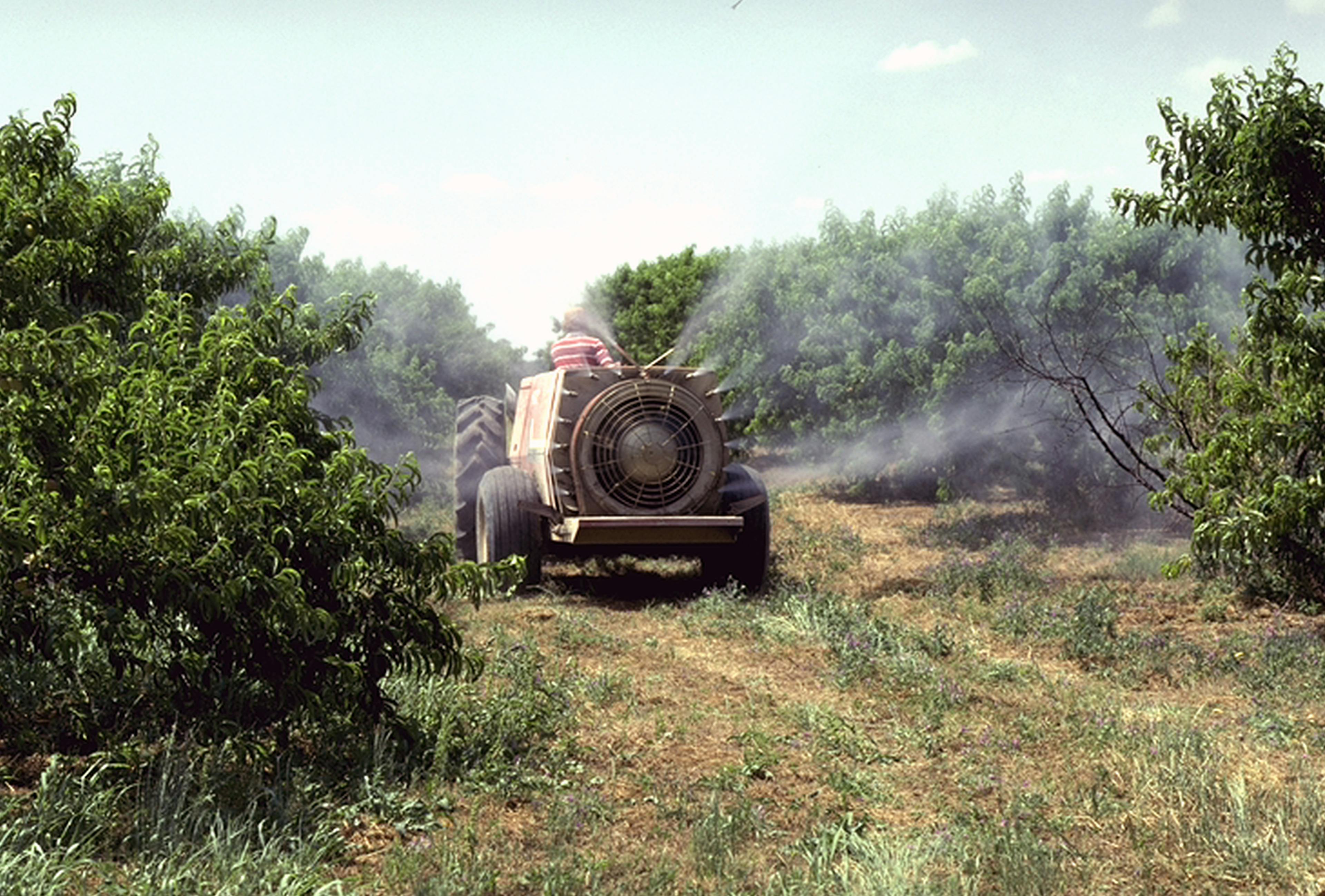
Pesticide being sprayed on an orchard. Photo: USDA.
A Necessary Evil?
Chemical pesticides came first to California agriculture as byproducts of oil refining and from chemical weapons and disinfectants used in the two World Wars. As with elsewhere in the world where industrial agriculture dominates, farmworkers and their families face serious threats to their health from exposure to the harmful chemicals.
Skeptics of pesticide activism point to California's sophisticated regulations as an adequate protection to ensure safe use. Yet these regulations have done nothing to slow the increase in pesticide-related illnesses. Founded on the logic that "the dose makes the poison," the so-called threshold paradigm underlying California pesticide regulation assumes that it's possible for each toxic substance to find a "safe level of exposure." The threshold paradigm is used to relegate deeply political decisions to the apolitical domain of "decision science" (which uses quantitative methods and techniques to support decision making processes).
There are several problems with applying the threshold paradigm to agricultural pesticides. First, it is notoriously difficult to model the movement of toxins through the environment and into the human body. Most models consider only point-source pollution, which refers to the levels of toxins at a single site, whereas pesticides can drift out of multiple sites in each application. Modeling becomes even more complicated when considering the combined health risks of exposure to multiple types of pesticides. As a result, even the best models may fail to adequately predict whether a given pesticide application exceeds the safe threshold.
While many of California's approved fumigant pesticides are known carcinogens, neurotoxins, and hormone disruptors, the full severity of their impacts may be realized only decades later, by which time farmworkers cannot produce "definitive" links between their illness and a lifetime of pesticide exposure.
Second, the criteria for success that are built into the models are themselves shaped by political agendas that constrain what "counts" as evidence. For example, while many of California's approved fumigant pesticides are known carcinogens, neurotoxins, and hormone disruptors, the full severity of their impacts may be realized only decades later, by which time farmworkers cannot produce "definitive" links between their illness and a lifetime of pesticide exposure.
Third, the threshold paradigm masks the ways in which technical solutions can continue and be used to justify a history of environmental racism. In the case of fumigants, the prominent "buffer zone" solution, which requires a buffer of some distance between fumigated fields and nearby neighborhoods, does nothing to reduce the exposure of farmworkers in the fields.
But are the well-known negative effects of pesticides and synthetic fertilizers really a necessary evil in protecting our society's food supply? Is it something we – and particularly those of us unfortunate enough to live near or to work on the farms – have to deal with so that the world can be fed? As it turns out, absolutely not!
Envisioning Pesticide-Free Futures
There is a growing movement in California, connected to similar struggles across the world, fighting to limit the use of pesticides in agriculture.
In response to the social and environmental consequences of industrial agriculture, farmer and peasant activists have fought back with agroecology. As a social movement, agroecology takes diverse approaches towards building sustainable and just food systems. As a science, agroecology considers the whole agroecosystem and examines the ways that diversified food systems support soil health, biodiversity, and food production. As a practice, agroecology adapts ecological science and traditional knowledge to local conditions, considering the ecological, social, political, and economic dimensions of those conditions. Agroecology is a multi-pronged movement for food sovereignty – the self-determination of farmers to choose what and how to grow in the context of a globalized food system. Agroecology demands an end to industrial agriculture and its reliance on external inputs, of which pesticides are a key component.
For the agricultural communities of the Monterey Bay area and beyond, exposure to pesticides is part of the long history of farmworker precarity in an industrial, capitalist agricultural system that depends on and profits from their exploitation.
The echoes of agroecological movements can be heard in organizations where people around the world are struggling to oppose pesticides. At the international level, Pesticide Action Network (PAN) brings together over 600 nongovernmental organizations, institutions and individuals in over 90 countries who are working to replace the use of hazardous pesticides with ecologically sound and socially just alternatives. PAN partners with Californians for Pesticide Reform (CPR), a coalition of more than 190 organizations fighting to "fundamentally shift the way pesticides are used in California" and "challenge the powerful political and economic forces opposing change."
SASS is a member of CPR in the Monterey Bay area. In recent months, SASS members have worked tirelessly to bring the Right To Know campaign before regional city councils and school boards. Through their efforts, several city councils in the Monterey Bay region have already voted in support of the campaign. On June 21, twenty-five scientists of the University of California signed a letter to Governor Newsom demanding that Notices of Intent be made public, characterizing the Right To Know as an environmental justice issue.
For the average California consumer, pesticides are a problem only if they contaminate their food; in response, many who can afford it opt for organic produce. But for the agricultural communities of the Monterey Bay area and beyond, exposure to pesticides is not a matter of individual choice. Rather, it is part of the long history of enforced powerless of the farmworker in an industrial, capitalist agricultural system that depends on and profits from their exploitation.
Pesticide use, and the industrial model of agriculture that it sustains, is a highly intersectional issue: land, labor, environment, public health, and race are all involved. Building towards collective liberation across these issues and envisioning a pesticide-free world starts with agricultural communities securing the Right to Know.
Science for the People (SftP) is an activist organization that starts from the idea that science is not an abstraction removed from society. Rather it is produced by the labor of workers in science and technology. But under capitalism, the conditions of this production and the use of science are controlled by the wealthy and powerful. In SftP we fight for a science that serves all people, organizing wherever science is produced or applied alongside all those fighting for justice. The Santa Cruz chapter of SftP has been active in counter-recruiting on the UCSC campus, supporting the Mauna Kea Protectors, conducting research on houselessness in Santa Cruz, and participating in the SASS coalition.
